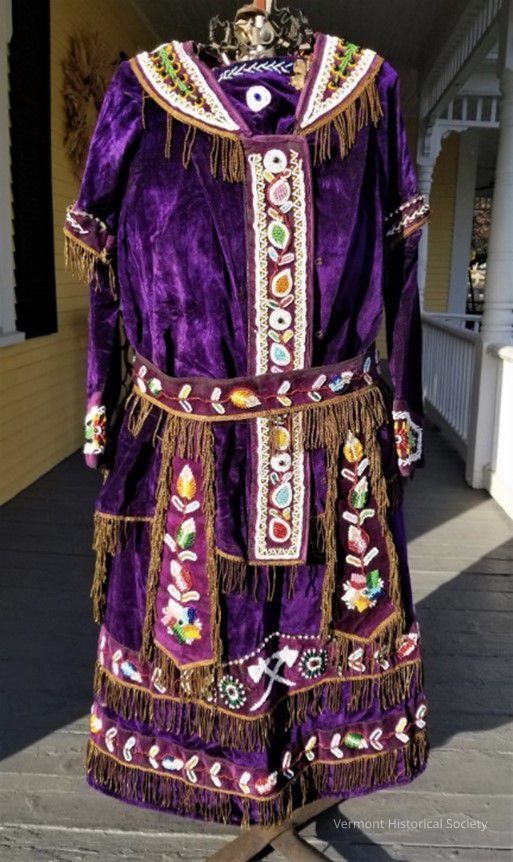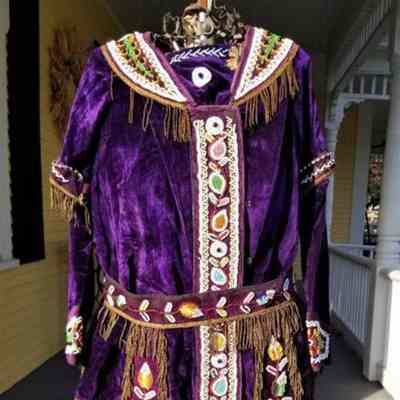Woman's Outfit
Name/Title
Woman's OutfitEntry/Object ID
L2024.3.137a-gDescription
Overall the outfit is mainly purple with extensive beading. a. Blouse - Little, thin white edged “vine” leaves to stylistically link it to the skirt and belt; but that is it. All the larger blouse leaves have white, two- and three-bead wide margins with a colored fill beaded at 45-degrees to the leaf axis such as are commonly found in Maine and New Brunswick foliar examples. The leaves are interspersed with circular white sun/moon discs with a central “padre”-sized bead. They are all connected to each other with vines of red, white-heart beads, nary a transparent or clear bead to be seen! Edging is the old and typical zigzag band, executed in white. Everything is edged with metallic braid. b. Skirt c. Tasset Belt - The tassets have three-tone leaves with midribs and transparent red and clear beads, presaging the Late Niagara Style, as well as a five-pointed star with little starbursts in the corners, also occasionally seen on later Niagara beadwork. The tasset also has thin, white edged leaflets connected to the larger leaves and the star by vining stems executed in transparent, red beads. These colorful leaflets with white borders do not occur in other coeval examples of Iroquoian beadwork that I am familiar with. There are rare leaflets of similar design that occur (with colored, not white, margins) on much earlier Early Niagara Bead-work but nothing from the late 19th century. d & e. Leggings - The leggings have the bead-work appliqued directly to the body. There is also a unique (to Wiseman's knowledge) flexible legging lacing system to allow the tapered legging tube to closely conform to the woman's calf shape. f & g. Moccasins - Niagara-style (Haudenosaunee)Context
Originally of Abenaki (or Kahnawake Mohawk) make, it was used in the Middle Connecticut River Valley and is in exquisite condition. It consists of a blouse, skirt, leggings and tasset belt covered with beautiful beadwork. There is a dated 1919 “whimsey” that has somewhat similar designs such as the “stars” on the tassets or the thin, white-outlined leaflets seen on all parts of the outfit. This is the only evidence of a date. Abenakis such as former Koas Chief Nancy Millette and Missisquoi Citizen Fred Ball had early 20th century ancestors who apparently wore such lavish outfits in traveling medicine shows. This outfit is possibly the most complete and beautiful example of beadwork in the Abenaki Cultural Conservancy collection. It is possibly Abenaki made, almost certainly Abenaki worn, woman's ensemble purchased in Pennsylvania, it comes with a significant amount of oral history: "It belonged to my great grandmother. It was stored in my great grandmother’s closet, then my grandmother’s, and then back in the '60s my father had it stored away in an old suitcase, and it's been sitting there ever since, so there's really not much discoloration or damage, as far as I can tell." Peter------- Pocono Lake, PA 10/26/2021Acquisition
Source (if not Accessioned)
Abenaki Cultural ConservancyMade/Created
Date made
circa 1920Ethnography
Culture/Tribe
Abenaki, Iroquois, Mohawk
Native American, First Nation

